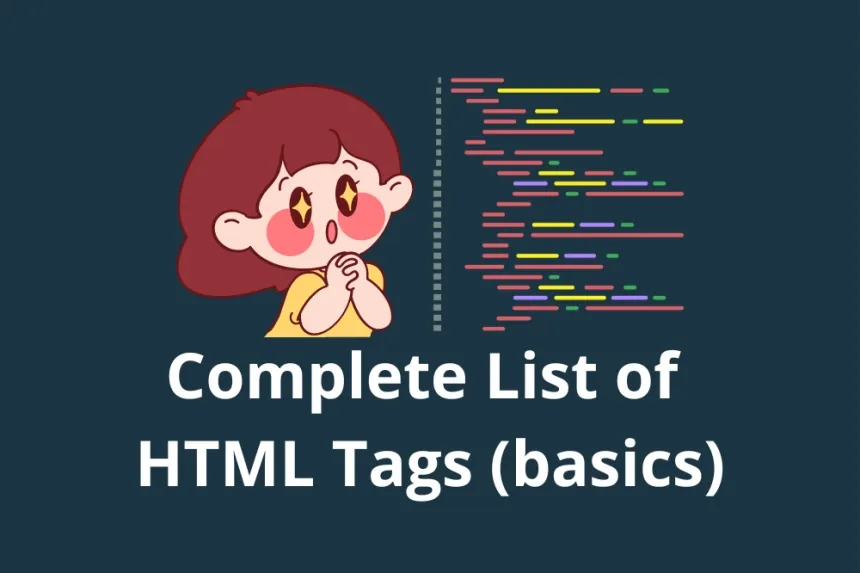Complete List of HTML Tags An Essential Guide for Web Developers


In the world of web development, HTML (HyperText Markup Language) is the foundational language for creating structured and functional web pages. HTML tags are the fundamental building blocks that enable you to structure content, apply styles, and add functionality. In this comprehensive guide, we will explore the most important HTML tags, their purposes, and how to use them effectively.
Introduction to HTML Tags
HTML uses a series of tags to define different types of content on a web page. These tags are enclosed in angle brackets < > and usually come in pairs, with an opening tag and a closing tag. For example, the opening tag <p> and the closing tag </p> are used to define a paragraph.
Basic Structure Tags
html
The <html> tag is the root container of an HTML document. All content on the web page must be contained within this tag.
<html>
<head>
<title>My Web Page</title>
</head>
<body>
<!-- Content here -->
</body>
</html>head
Within the <head> tag, you place the metadata of the page, such as the title, links to stylesheets, and scripts.
<head> <meta charset="UTF-8"> <meta name="description" content="Description of the page"> <title>My Web Page</title> </head>
body
The <body> tag contains the visible content of the page, including text, images, and other multimedia elements.
<body> <h1>Welcome to My Web Page</h1> <p>This is a sample paragraph.</p> </body>
Heading Tags
h1 - h6
The heading tags <h1> through <h6> are used to define headings in a document. <h1> is the highest level, while <h6> is the lowest level.
<h1>Main Heading</h1> <h2>Subheading</h2> <h3>Sub-subheading</h3>
Text Formatting Tags
p
The <p> tag defines a paragraph of text. It is one of the most basic and common HTML tags.
<p>This is a text paragraph.</p>
strong and em
The <strong> and <em> tags are used to emphasize text. <strong> is generally used for important text, while <em> is used for emphasis.
<p><strong>Bold text</strong> and <em>italic text</em></p>
Link and Image Tags
a
The <a> tag is used to create links to other web pages or resources. The href attribute specifies the URL of the destination.
<a href="https://www.example.com">Visit Our Site</a>
img
The <img> tag is used to insert images. The src attribute defines the path to the image, while alt provides an alternative description.
<img src="image.jpg" alt="Image description">
List Tags
ul and ol
The <ul> (unordered list) and <ol> (ordered list) tags are used to create lists of items. <li> defines each list item.
<ul> <li>Item 1</li> <li>Item 2</li> </ul> <ol> <li>First item</li> <li>Second item</li> </ol>
Form Tags
form
The <form> tag defines a form for user input. Inside <form>, you can use tags like <input>, <textarea>, and <button>.
<form action="/submit" method="post"> <label for="name">Name:</label> <input type="text" id="name" name="name"> <input type="submit" value="Submit"> </form>
Table Tags
table, tr, td, th
Although this guide avoids the use of tables, it's important to know that <table>, <tr>, <td>, and <th> are used to create tables in HTML. <table> defines the table, <tr> defines a row, <td> defines a data cell, and <th> defines a header cell.
<table>
<tr>
<th>Header 1</th>
<th>Header 2</th>
</tr>
<tr>
<td>Data 1</td>
<td>Data 2</td>
</tr>
</table>Conclusion
Understanding and mastering HTML tags is essential for any web developer. These tags not only allow you to structure a web page's content but also facilitate creating a rich and functional user experience. By knowing the purpose and correct implementation of each tag, you can build more efficient and well-organized websites.
To keep your skills up to date, it is important to stay informed about new tags and attributes that HTML continues to introduce. With this guide, we hope to have provided you with a solid foundation on the essential HTML tags you need to know.
I know there are some tags missing here but we will see them in the next article.
You can see the next article -> Essential HTML5 Tags: Expanding Your Web Development Toolkit
Article information
Key tips
Take your time to understand each concept before moving on to the next one.
Practice the examples in your own development environment for better understanding.
Don't hesitate to review the additional resources mentioned in the article.


















